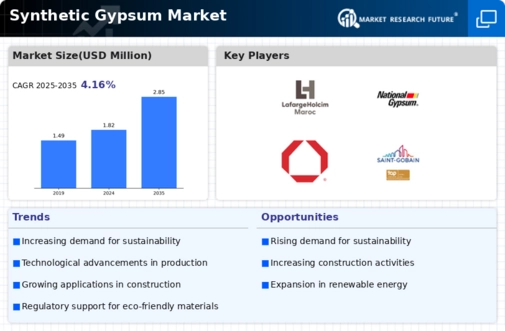Market Analysis
In-depth Analysis of Synthetic Gypsum Market Industry Landscape
Evolving trends define the current state of synthetic gypsum industry’s landscape which is full of dynamic characteristics. For instance, synthetic gypsum has been developed from other industrial processes such as flue gas desulphurization (FGD) in power plants or phosphoric acid production for ecological reasons. World construction industry majorly contributed to increased demand for synthetic gypsum like other types of gypsum materials.
One thing having an impact on market dynamics is increasing awareness and emphasis on green building practices. As recycled material, the use of synthetic gypsum falls under global initiatives for environmentally friendly buildings. Thus, there has been an ongoing trend in construction; using synthetic instead natural gypsum in making plasterboard or cement among other gypsum-based products lowers its carbon foot print.
Governments have also had a crucial role regarding regulation and policy making especially emissions control directed towards this particular type of mineral resources within its man-made forms. Industrial directives dictated FGD systems installations which were higher than before due to stringent standards requiring reduction in emissions resulting from sulfur dioxide occurring from these industrial procedures by coal based power generation plants. Consequently significant quantities of synthetic gypsum became available leading to its expanded market. Governments all over the world are encouraging the use of synthetic gypsum in order to minimize dependency on natural resources.
Moreover, there is also a direct influence on dynamics of the synthetic gypsum market today caused by a construction boom in developing countries. The rate of urbanization and infrastructure development projects in countries like China, India and Brazil has boosted demand for gypsum based products. Cheapness and versatility while constructing materials have made synthetic gypsum preferable option especially for builders and developers within these areas.
Synthetic Gypsum’s supply side market dynamics are influenced by its production processes. Industrial activities generate more such by-products which act as feedstock for producing synthetic gypsum. Efficiency and cost are among the factors that can be affected by technological advancements in methods used to extract or process synthetic gypsum thus influencing market dynamics.
Within the synthetic gypsum market there is a competition between several major firms. They are emphasizing on strategic alliances, mergers and acquisitions to strengthen their positions in different markets while increasing their product variety. Also, there have been investments on product development and technology to enhance the quality and performance of synthetic gypsum in meeting changing user requirements.
Fluctuation in raw material prices and overall economic climate also affects Market dynamics. Volatile price changes in natural gypsum and energy costs can affect production costs of these products thereby influencing market trends. Besides this, it can influence building activities across various nations that may indirectly cause either inflows or outflows globally due to economic uncertainties or geopolitical factors.







Leave a Comment